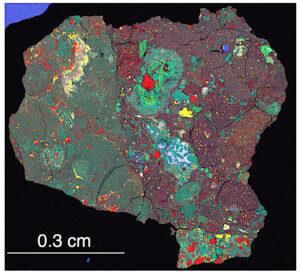Marrocchi, Y. ; Delbo, M. ; Gounelle, M. (2021) Meteoritics & Planetary Science, 56, 7, 1406-1421
Voir en ligne : https://doi.org/doi:10.1111/maps.13716

Abstract :
Chondrites are leftover solids from the early evolution of the solar protoplanetary disk that never experienced melting since their formation. They comprise unequilibrated assemblages of low- and high-temperature components, including volatile-rich, fine-grained matrices, Fe-Ni metal, sulfides, refractory inclusions, and chondrules. Consequently, chondrites are commonly described as pristine, primitive, or primordial rocks of the solar system. However, impact-generated secondary features are abundant in chondrites, suggesting that collisions among early-formed planetesimals and their fragmentation and reassembly have been effective throughout the evolution of the solar system. In this report, we review evidence of the major role of impacts in generating the current mineralogical and petrographic characteristics of chondrites. We provide perspective to these meteoritic features by discussing recent analyses of large-scale structures of the main asteroid belt and remote-sensing observations of asteroids. Observations at various spatial scales all attest that the “primitive” materials formed during the evolution of the solar system have largely been reprocessed, confirming previous studies that primitivity is relative, not absolute. This implies that (1) chondrites (and some differentiated meteorites) should systematically be envisioned as reprocessed and heterogeneous materials and (2) brecciated meteorites should be considered the norm and unbrecciated meteorites the exception.



